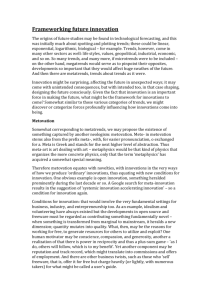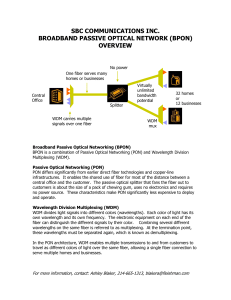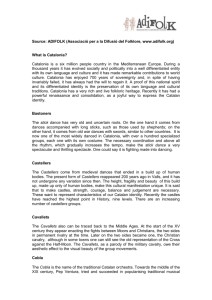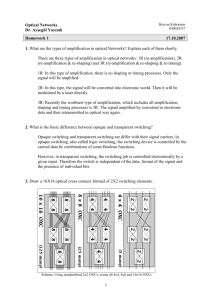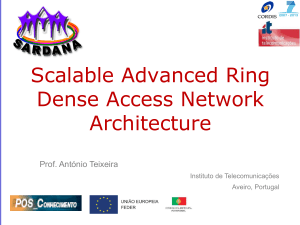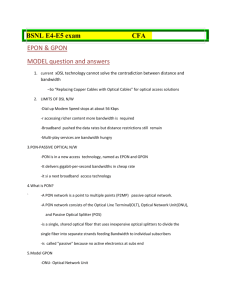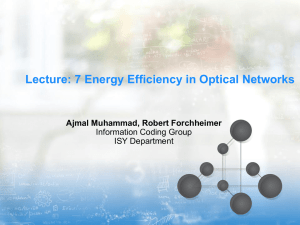project factsheet
advertisement
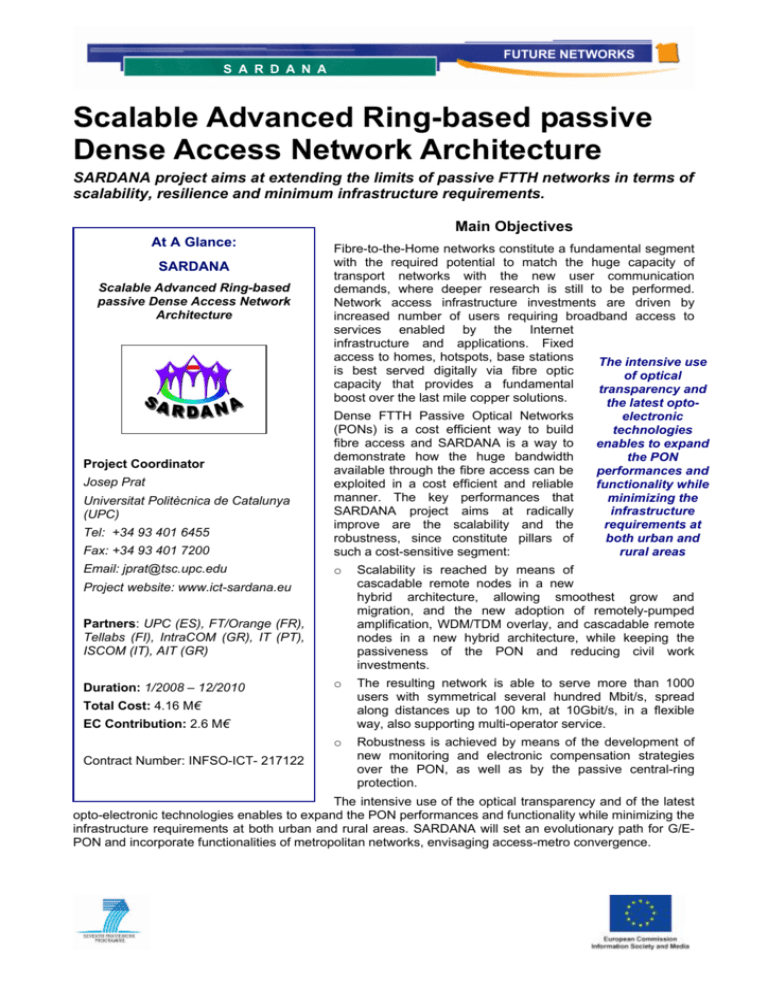
FUTURE NETWORKS S A R D A N A Scalable Advanced Ring-based passive Dense Access Network Architecture SARDANA project aims at extending the limits of passive FTTH networks in terms of scalability, resilience and minimum infrastructure requirements. Main Objectives At A Glance: SARDANA Scalable Advanced Ring-based passive Dense Access Network Architecture Fibre-to-the-Home networks constitute a fundamental segment with the required potential to match the huge capacity of transport networks with the new user communication demands, where deeper research is still to be performed. Network access infrastructure investments are driven by increased number of users requiring broadband access to services enabled by the Internet infrastructure and applications. Fixed access to homes, hotspots, base stations The intensive use is best served digitally via fibre optic of optical capacity that provides a fundamental transparency and boost over the last mile copper solutions. the latest opto- Fax: +34 93 401 7200 Dense FTTH Passive Optical Networks (PONs) is a cost efficient way to build fibre access and SARDANA is a way to demonstrate how the huge bandwidth available through the fibre access can be exploited in a cost efficient and reliable manner. The key performances that SARDANA project aims at radically improve are the scalability and the robustness, since constitute pillars of such a cost-sensitive segment: Email: jprat@tsc.upc.edu o Scalability is reached by means of cascadable remote nodes in a new hybrid architecture, allowing smoothest grow and migration, and the new adoption of remotely-pumped amplification, WDM/TDM overlay, and cascadable remote nodes in a new hybrid architecture, while keeping the passiveness of the PON and reducing civil work investments. o The resulting network is able to serve more than 1000 users with symmetrical several hundred Mbit/s, spread along distances up to 100 km, at 10Gbit/s, in a flexible way, also supporting multi-operator service. o Robustness is achieved by means of the development of new monitoring and electronic compensation strategies over the PON, as well as by the passive central-ring protection. Project Coordinator Josep Prat Universitat Politècnica de Catalunya (UPC) Tel: +34 93 401 6455 Project website: www.ict-sardana.eu Partners: UPC (ES), FT/Orange (FR), Tellabs (FI), IntraCOM (GR), IT (PT), ISCOM (IT), AIT (GR) Duration: 1/2008 – 12/2010 Total Cost: 4.16 M€ EC Contribution: 2.6 M€ Contract Number: INFSO-ICT- 217122 electronic technologies enables to expand the PON performances and functionality while minimizing the infrastructure requirements at both urban and rural areas The intensive use of the optical transparency and of the latest opto-electronic technologies enables to expand the PON performances and functionality while minimizing the infrastructure requirements at both urban and rural areas. SARDANA will set an evolutionary path for G/EPON and incorporate functionalities of metropolitan networks, envisaging access-metro convergence. In order to fulfil the multi-disciplinary tasks and to reach the challenges, the SARDANA partners join their expertises: Technical Approach The pursued novel SARDANA network transparently combines the WDM (Wavelength o UPC: Coordination, subsystem design. Division Multiplexing) and the TDM (Time Division o FT: Architecture definition, ONU, Field-trial, Technical Multiplexing) dimensions to reach the extra-large management, Techno-Economic studies. user-density. The proposed completely passive o Tellabs: GPON equipment, MAC, lab-demonstration. resilient FTTH network is based on a WDM ring o IntraCOM: Management for the transport of the &Control plane, Service large amount of platform. ONU ON 1:K downstream and upstream λ ,…, λ o IT: Monitoring system, nonONU ON RN2 information (up to 1.2Tbit/s linear transmission. ONU ON RN1 λ ,…, λ if using 64 wavelengths for o ISC: Remote nodes, non-linear TDM TREE RNi 2000 users) and TDM amplification. Upstream Signals 1:K ONU ON ONU trees, transmitting several RSOA o AIT: Electronic PON impairment WDM RING CO ONU ON compensation, Technowavelengths from RNj Economic studies. corresponding operators, λ ,…, λ PIN/APD 1:K sharing a common RNN Bidirectional Transmission Expected Impact RNN-1 infrastructure. Passive ONU ON The Objectives and expected Remote Nodes (RN), which Downstream Signals λ ,…, λ Impact of SARDANA are: implement cascadable 2to-1 fibre optical Add&Drop o One order-of-magnitude functions distribute extension of current PON SARDANA PON different wavelengths to performances, “aimed at each of the access trees; overcoming the expected remote amplification is long term limitations of introduced at the RN by current internet means of Erbium Doped capabilities, architecture Fibres (EDFs) to and protocols”. compensate add/drop o Smooth and increased losses; optical pump for the scalability and backwards remote amplification is compatibility migration provided by pumping from currently deployed lasers located at the PONs. Since operators face a high degree of Central Office (CO), also providing extra Raman uncertainty at this level (take rates, user gain along the ring. Regarding the digital demands, etc) and the necessity of feasibly terminals, the SARDANA project aims at reuse, as deferring the investments, incremental much as possible, standard G/E-PON equipment scalability has become a major objective, as of current and next-generation 10G-versions, denoted in the FP7 Target Outcomes. performing a quasi-transparent overlay between D 1 D m U D 1 U 2N U 1 U 2N m+1 D 2N SARDANA CO Standard Optical 10G-GPON Interface OLT SERVICE PLATFORM SARDANA ONT MUX & Standard Optical 10G-GPON Interface OLT PUMP SARDANA & PON refl.optical Interface Standard 10G-PON ONT ROUT. & Standard Optical xPON MONIT. Interface OLT CONTROL (control&management, monitoring, compensation) TDM and WDM layers. The work in SARDANA is organized into several inter-related Work-Packages: 1. WP-Mg: Project Management and Outcomes. 2. WP-Ar: Network Architecture. 3. WP-Mc: MAC and Higher Layers 4. WP-Tr: Transmission and modulation formats. 5. WP-Sy: Network Subsystems. 6. WP-Im: Monitoring and adaptive compensation of PON Impairments. 7. WP-Dm: Demonstrator and Field-trial. During the project live, a Sardana Network demonstrator will be built, engineered and multilayer operated; its main features will be also demonstrated in a field trial, delivering new generation bidirectional services to residential users. o Establishment of new intelligent monitoring and compensation strategies to combat impairment and faults for a trusted robust PON. o Implementation of the MAC, the Control and Management planes, to demonstrate basic resiliency, wavelength balancing and improved service-aware traffic control. o Economic effectiveness of the extended PON approach. o Demonstration and field-trial of the SARDANA network. o Recommendation for a technical solution of a multi-operator shared infrastructure as an input to European and National Regulatory bodies. o SARDANA will result with experience and IPR that helps European industry and research to develop a competitive advantage. SARDANA March 2008
